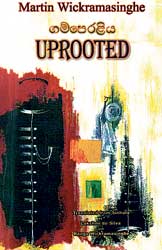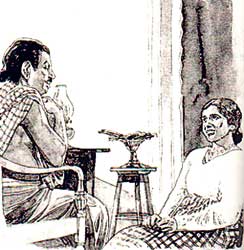The smooth black ribbon of road linking the southern towns of Galle and Matara runs between the village and the sea. Verandahs are a feature of each village house, whilst the sea-shore is the panoramic front-verandah for the entire village. On an embankment a few feet above ground level, the rail-track extends as far as the eye can reach, like a long ladder with no beginning and no end. The scooping of earth to raise the embankment many years ago has left long ditches on either side. Water from little streams running under numerous culverts has collected in the ditches to form little ponds that abound in water lilies and lotuses, and little fish.
 |
This picture of the village of Koggala was 'drawn' by Sri Lanka's most outstanding literary figure in recent history, Martin Wickramasinghe 65 years ago in the landmark novel, 'Gamperaliya' - the first part of a trilogy discussing the social changes in the country in the early part of the 20th century. According to the author, the backdrop and events described in the book related to the period around 30 years earlier when the country was under colonial rule.
Just as much as 'Gamperaliya' continues to be popular among both the young and old, readers are now able to enjoy its English version. Titled 'Uprooted', it has been translated by Lakshmi de Silva, one-time university don and acclaimed translator of creative writing from Sinhala into English (she translated 'Ape Game' in 1968) and Ranga Wickramasinghe, who not so long ago released a translated collection of Martin Wickramasinghe’s short stories.
'Uprooted' will particularly be a boon to English readers who were hitherto unable to enjoy the Sinhala version. They will find that 'Uprooted' is not mere fiction. Through the story of Don Adrian Kaisaruwatte Muhandiram ('Muhandiram' was an honorary title conferred by the administration on influential village gentry after which the household came to be called the 'Walauwe'), an elder of the land-owning class, 'Uprooted' discusses the many aspects of village life including traditional customs, festivities, different characters and other interesting tales. Though the backdrop is a village in the south, these are common to almost the entire country with possibly a few adjustments here and there.
The reader is able to picture vividly the different types of characters in the village through the descriptions of the personalities in the story. As for the elderly Muhandiram, "flecks of black stood out in the white beard that covered his cheeks, like the sparse scatter of unhusked black grains in a heap of husked white kurakkan. The white beard, framing the face on either side, spread out on two sides like the white hair on the face of a Macacus monkey. The beard gave him a venerable appearance and complemented the intelligence behind his high forehead. The domed shape of the forehead was testimony to the keen intellect behind it. Like the tight fitting lids of a snuff-box, his thin lips closed firmly over his teeth and enhanced the comeliness of his face."
The majority of men in the village combed their hair and twisted it into a tight knot at the back of the head. Piyal, the young man, who had studied in English, was different to most others in the village.
Matara Hamine, the Muhandiram's wife was the typical lady of the village full of compassion. "Before washing her fingers after the midday meal of rice, she never forgot to place a ball of rice in the upturned coconut shell borne on a stick planted in the rear fence of the compound, just outside the detached kitchen at the back of the house. This was for the crows to feed on. If a beggar turned up whilst she was having a meal, he rarely left without assuaging his own hunger. She never failed to send a tray of rice and curried vegetables to the priests of the temple every day of the full moon."
The first signs of the changing fate of Muhandiram's family are portrayed through the deterioration of the walauwe. "When a sudden thunderstorm broke accompanied by strong gusts of wind, drops of water splashed onto the floor in a corner of the hall. Matara Hamine looked up at the roof and saw the water dripping through a cracked tile.
She fetched an empty brass spittoon from inside the house and positioned it on the wet floor to catch the water dripping from the roof. It was not only in the hall that water dripped onto the floor of the house through broken tiles, which had not been replaced for sometime. The leaks in the roof had contributed to the hastening of the inevitable decay of the Mahagedara."
Discussing the conflict of thoughts in the mind of Nanda, the dutiful daughter of the Kaisaruwatte family, the author describes the status of the woman in the social environment. "The social milieu of the village encouraged the women, of the gentry as well as others, to firmly uphold the sanctity of marital and family life and frowned on violations of those traditions. Modern lifestyles that encouraged a little laxity in this regard was confined to only a very few amongst the genteel families.”
The attention to detail in describing even a simple thing has been captured by the translators in a manner that the reader is able to picture the incident vividly.
The book with 200-plus pages is absorbing reading. Just as much as the story is interesting, the gradual transformation from peasant to urban culture is portrayed vividly. The translators have done a good job.
'Uprooted' also carries some fine sketches of a few episodes from the award winning film made by Lester James Peries which bring back memories of the golden days of Sinhala cinema.
'Gamperaliya' is about the changing village. One can wonder whether the title 'Uprooted' conveys this. For most readers it's not a problem since the cover prominently displays the Sinhala title too. And for others, Martin Wickramasinghe is no stranger. He wrote the novel "to give serene joy to the people by presenting a microcosm of the life of the Sinhala people of our times". The English version justifies the author's expectation. And of course, readers will now wait for the Martin Wickramasinghe Trust to give them the other two parts of the Trilogy - 'Kaliyugaya' (The Village and the City) and 'Yuganthaya' (The City) sooner than later.
|



